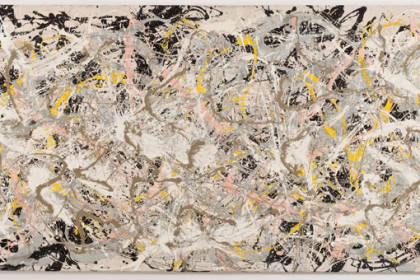
An impossible comparison: Auguste Rodin and Jackson Pollock. The one a refined sculptor lived in the nineteenth century, the other cursed painter who has forever changed the New York painting scene in the Fifties. No affinity, no point in common, but after having visited the two current exhibitions at Palazzo Reale in Milan on the same day, a reflection on the procedures of making art bloomed in us, a reflection on the techniques and poetics of the two artists, and why not, on artists of all time.
Among scaffolding pipes and white veils that separate the sculptures and set them apart from the amazing Hall of Caryatids, we have the works of the French artist, all in marble, in a delightful show that guides visitors towards two insights: on the one hand the evolution of Rodin‘s style from neoclassical models, through the study of Michelangelo, to the unfinished technique that allowed the sculptor to bring bodies out of the stone without completely carving them out; on the other hand, and that is what interests us the most, the great importance within the atelier of Rodin, of the rough-hewers. The captions indicate the names of these marble workers, finally acknowledging the dignity of those who “technically” made the work starting from the artist’ sketches of clay and chalk. Those rough-hewers worked under the direct control of Rodin, but, looking at the works, we have to acknowledge how the tension is lost in a watered-down version, which emphasizes a sleek eroticism, while blurring the power arising from the sketches that peek next to the marble, or the famous bronzes where the bodies are more close than ever to Michelangelo and the communicative power is at its highest in the whole history of sculpture. In the marble statues we perceive clearly the idea, the poetics of Rodin, but the execution, as nearly always happens in the field of sculpture, is entrusted to others, without undermining the character of authenticity.
We go down to the ground floor of Palazzo Reale and there we meet Jackson Pollock, surrounded by the “irascibles”, those who made the great so-called New York School. The white veils give way to dark gray walls, with an intense atmosphere that helps us focusing on the paintings, drawings, colors, the exhibition shows photographs, original videos, films as well and it all allow us to immerse ourselves in an art which, unlike that of Rodin, revolves around gesture. No picture, only energy, fluid painting that falls on the canvas with impetuosity, imparting a sense of movement and emotion and an explosive personality and genius that is undeniably tangible in the main painting exhibited, Number 27 of 1950. Next to it, examples of all the members of American Abstract Expressionism, Willem de Kooning, Robert Motherwell, Franz Kline, and Mark Rothko, who closes the path with two extraordinary paintings in a niche, almost a sacred space of meditation to enclose their power.
Two different worlds, those of Rodin and Pollock, two ways of working at the antipodes of art making and that mark clearly the transition that, by stages, became increasingly linked to autography, ruled out the team work – used, in painting as well as in sculpture, from the Middle Ages to the last century – until it became a true performance in its various forms.
Rodin. Il marmo, la vita
Milan, Palazzo Reale, Hall of the Caryatids
Edited by Aline Magnien in collaboration with Flavio Arensi
Until January 26th, 2014
Pollock e gli irascibili. La scuola di New York
Milan, Palazzo Reale
Cared by Carter Foster in collaboration with Luca Beatrice
Until February 16th, 2014
 English
English  Italiano
Italiano 



